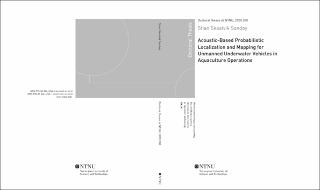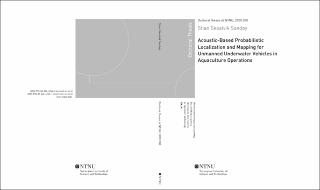| dc.contributor.advisor | Schjølberg, Ingrid | |
| dc.contributor.advisor | Bouwer, Ingrid | |
| dc.contributor.author | Sandøy, Stian Skaalvik | |
| dc.date.accessioned | 2020-06-12T13:43:08Z | |
| dc.date.available | 2020-06-12T13:43:08Z | |
| dc.date.issued | 2020 | |
| dc.identifier.isbn | 978-82-326-4765-1 | |
| dc.identifier.issn | 1503-8181 | |
| dc.identifier.uri | https://hdl.handle.net/11250/2657936 | |
| dc.description.abstract | The aquaculture industry needs automation to meet the world's increasing demand for fish protein. However, it is considered to be one of the most dangerous occupations in Norway due to the required amount of manual labor with heavy equipment in demanding weather conditions. One of the operations in need of improvement is the inspection of submerged equipment, which, nowadays, is performed by divers and remotely underwater vehicles (ROVs). The former is a high-risk operation for personnel, and the latter demands heavy lifting during launch and recovery, which is also considered a high-risk task.
Autonomous vehicles could perform these tasks to reduce risk; however, many challenges need to be solved before this becomes a reality, one of which is navigation in an aquaculture environment. This thesis addresses this challenge, presents tank and field experiments to validate some suggested methods, and compares the suggestions against existing methods. The thesis examines four novel algorithms in terms of two topics. The topics are localization and mapping using exteroceptive sensors, which measures the environment from a vehicle's egocentric perspective, and localization using environmental sensors, which measures position from an external point of reference. The external point of reference means that the sensors have a known location in the environment. From an egocentric perspective, there is a group of methods called simultaneous localization and mapping (SLAM). SLAM is a mature field; however, there are still challenges related to the use of sonar as an exteroceptive sensor. The high number of outliers and the nonlinear noise distributions pose a challenge to current methods.
The first method presented is primarily a sonar likelihood model that addresses outlier measurement issues. The likelihood model is integrated into a scan-matching method and in a Rao-Blackwellized particle filter SLAM method, and then compared with other SLAM methods. The results show that the suggested method has a better runtime and localization accuracy than the other methods.
The second issue addressed is the mapping of an aquaculture environment, or more specifically, the mapping of a dynamic fish cage using exteroceptive sensors such as sonar. Conventional methods involve memory consumption that scales cubically with volume. The suggested approach, named polar map, scales quadratically with the size of the environment. It not only makes the method far more memory efficient in large environments, but gives a lower runtime complexity than conventional mapping representations when used in SLAM solutions. The verification of the map representation used tank experiments, where an unmanned underwater vehicle (UUV) performed SLAM using the suggested representation. This thesis also compares the use of two other map representations, namely the 3D occupancy grid map and the octomap, with the polar map.
The third issue addressed is the use of an environmental sensor to create a map representation of an anchor line. Hydrophones obtain the positions of acoustic tags placed on the line, which generate the map. This work presents field experiments, and the results show that the performance of the equipment had satisfactory accuracy for generating an initial map of an environment.
The fourth challenge addressed is the use of a hydroacoustic positioning system in the wave zone. Having a positioning system close to the surface simplifies the mounting and maintenance of equipment; however, wave-induced motion generates an oscillatory error in the position estimates of a UUV. The suggested solution is to use an extended Kalman filter that uses a wave filter to remove the wave motion in the final localization estimates of the UUV.
Thus, to summarize, the thesis presents four suggested methods for increasing automation in underwater inspections using a UUV in an aquaculture environment. | en_US |
| dc.language.iso | eng | en_US |
| dc.publisher | NTNU | en_US |
| dc.relation.ispartofseries | Doctoral theses at NTNU;2020:208 | |
| dc.relation.haspart | Article J1:
Sandøy, S.S.; Matsuda, T.; Sangekar M: Schjølberg, I.; Maki,T.;
Particle Filter-based Simultaneous Localization and Mapping for Underwater Vehicles with Sonar | en_US |
| dc.relation.haspart | Article J2: Sandøy, Stian Skaalvik; Hegde, Jeevith; Schjølberg, Ingrid; Utne, Ingrid Bouwer. Polar Map: A Digital Representation of Closed Structures for Underwater Robotic Inspection. Aquacultural Engineering 2020 ;Volum 89.
https://doi.org/10.1016/j.aquaeng.2019.102039
This is an open access article under the CC BY license (http://creativecommons.org/licenses/BY/4.0/) | en_US |
| dc.relation.haspart | Article J3:
Sandøy, S.S.; Haugaløkken, B.O.A.; Schjølberg, I.; Utne, I.B.
Localization of a Flexible Underwater Anchor Line using Acoustic Transmitter Tags and Receivers | en_US |
| dc.relation.haspart | Article C1: Sandøy, Stian Skaalvik; Schjølberg, Ingrid. Underwater Positioning Using Near Surface Long Baseline Transponder’s Induced by Wave Motion. I: ASME 2017 36th International Conference on Ocean, Offshore and Arctic Engineering - Volume 7A: Ocean Engineering. ASME Press 2017.
https://doi.org/10.1115/OMAE2017-61742 | en_US |
| dc.relation.haspart | Article C2: Sandøy, Stian Skaalvik; Schjølberg, Ingrid. Experimental verification of underwater positioning system in aquaculture. I: IEEE OCEANS 2017 - Aberdeen. IEEE conference proceedings 2017
https://doi.org/10.1109/OCEANSE.2017.8084947 | en_US |
| dc.relation.haspart | Article C3: Sandøy, Stian Skaalvik; Matsuda, Takumi; Maki, Toshihiro; Schjølberg, Ingrid. Rao-Blackwellized Particle Filter with Grid-Mapping for AUV SLAM Using Forward-Looking Sonar. I: Proceedings of MTS/IEEE Oceans'18, Techno-Ocean 2018 - OTO'18. IEEE 2018 ISBN 978-1-5386-1653-6. s. 1-9
https://doi.org/10.1109/OCEANSKOBE.2018.8559416 | en_US |
| dc.relation.haspart | Article C4: Haugaløkken, Bent Oddvar Arnesen; Sandøy, Stian Skaalvik; Schjølberg, Ingrid; Alfredsen, Jo Arve; Utne, Ingrid Bouwer. Probabilistic Localization and Mapping of Flexible Underwater Structures using Octomap. I: 2018 European Control Conference (ECC). IEEE 2018 ISBN 978-3-9524-2698-2. s. 268-275
https://doi.org/10.23919/ECC.2018.8550498 | en_US |
| dc.title | Acoustic-Based Probabilistic
Localization and Mapping for
Unmanned Underwater Vehicles in
Aquaculture Operations | en_US |
| dc.type | Doctoral thesis | en_US |
| dc.subject.nsi | VDP::Technology: 500::Marine technology: 580 | en_US |

